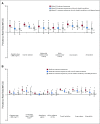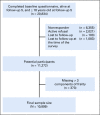Prevalence and Predictors of Frailty in Childhood Cancer Survivors and Siblings: A Report From the Childhood Cancer Survivor Study
- PMID: 31800343
- PMCID: PMC6968796
- DOI: 10.1200/JCO.19.01226
Prevalence and Predictors of Frailty in Childhood Cancer Survivors and Siblings: A Report From the Childhood Cancer Survivor Study
Abstract
Purpose: To estimate the prevalence of frailty among childhood cancer survivors and to determine the direct and indirect effects of treatment exposures, lifestyle factors, and severe, disabling, and life-threatening chronic condition on frailty.
Methods: Childhood cancer survivors (≥ 5 years since diagnosis), treated between 1970 and 1999 when < 21 years old (n = 10,899; mean age, 37.6 ± 9.4 years; 48% male, 86% white) and siblings were included (n = 2,097; mean age, 42.9 ± 9.4 years). Frailty was defined as ≥ 3 of the following: low lean mass, exhaustion, low energy expenditure, walking limitations, and weakness. Generalized linear models were used to evaluate direct and indirect associations between frailty and treatment exposures, sociodemographic characteristics, lifestyle factors, and chronic condition.
Results: The overall prevalence of frailty among survivors was 3 times higher compared with siblings (6.4%; 95% CI, 4.1% to 8.7%; v 2.2%; 95% CI, 1.2% to 3.2%). Survivors of CNS tumors (9.5%; 95% CI, 5.2% to 13.8%) and bone tumors (8.1%; 95% CI, 5.1% to 11.1%) had the highest prevalence of frailty. Survivors exposed to cranial radiation, pelvic radiation ≥ 34 Gy, abdominal radiation > 40 Gy, cisplatin ≥ 600 mg/m2, amputation, or lung surgery had increased risk for frailty. These associations were partially but not completely attenuated when sociodemographic characteristics, lifestyle factors, and chronic conditions were added to multivariable models. Cranial radiation (prevalence ratio [PR], 1.47; 95% CI, 1.20 to 1.76), pelvic radiation ≥ 34 Gy (PR, 1.46; 95% CI, 1.01 to 2.11), and lung surgery (PR, 1.75; 95% CI, 1.28 to 2.38) remained significant after sociodemographic, lifestyle, and chronic conditions were accounted for.
Conclusion: Childhood cancer survivors reported a higher prevalence of frailty compared with siblings. Radiation and lung surgery exposures were associated with increased risk for frailty. Interventions to prevent, delay onset, or remediate chronic disease and/or promote healthy lifestyle are needed to decrease the prevalence of frailty and preserve function in this at-risk population.
Figures







References
-
- Howlader N, Noone AM, Krapcho M, et al: Section 28: Childhood Cancer by Site: Incidence, Survival, and Mortality, in SEER Cancer Statistics Review, 1975-2016. Bethesda, MD, National Cancer Institute, 2018 https://seer.cancer.gov/csr/1975_2016/results_merged/sect_28_childhood_c....
-
- Song X, Mitnitski A, Rockwood K. Prevalence and 10-year outcomes of frailty in older adults in relation to deficit accumulation. J Am Geriatr Soc. 2010;58:681–687. - PubMed
Publication types
MeSH terms
Grants and funding
LinkOut - more resources
Full Text Sources
Other Literature Sources
Medical
Research Materials

